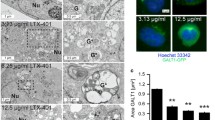Abstract
Two immunotoxins were prepared using monoclonal antibodies (mAb) directed towards two distinct epitopes of the gp185HER-2 extracellular domain, and the type I ribosome inactivating protein (RIP) plant toxin saporin 6. Cell protein synthesis inhibition assay reveals that the immunotoxins display a potent and specific cytotoxicity that is characterized by a slow rate, since the time required to inhibit incorporation of radiolabeled leucine completely ranges from 36 h to 60 h depending on the target cell line and the immunotoxin. Because this feature may hamper the immunotherapeutic use of these conjugates we analysed this further by studying the early phases of internalization of immunotoxins by immunoelectron microscopy. The results of this study have demonstrated that the distribution pattern of the immunotoxins and of the unconjugated mAb over the cell surface overlaps. Similarly the mAb and immunotoxins are internalized into the cell by two different pathways: via clathrin-coated pits or via smaller uncoated pits and vesicles. A higher degree of internalization is achieved when the two immunotoxins are used in combination. Unlike the slow kinetics of cell intoxication the process of immunotoxin endocytosis is characterized by a rapid rate of internalization (above 40% at 5 min in the SK-BR-3 cell line). Although these findings provide no clue to explain the mechanisms of the slow rate of cytotoxicity of the two immunotoxins their rapid internalization indicates that these reagents can be exploited in immunotherapeutic approches to gp185HER-2-expressing malignancies.
Similar content being viewed by others
References
Barbieri L, Dinota A, Gobbi M, Tazzari PL, Rizzi S, Bontadini A, Lemoli RM, Tura S, Stirpe F (1989) Immunotoxins containing saporin 6 and mAbs recognizing plasma cell-associated antigens: effects on target cells and on normal myeloid precursors (CFUGM). Eur J Haematol 42: 238
Berchuck A, Kamel A, Whitaker R, Kerns B, Olt G, Kinney R, Soper JT, Dodge R, Clarke-Pearson DL, Marks P, McKenzie S, Yin S, Bast RC (1990) Overexpression ofHER-2/neu is associated with poor survival in advanced epithelial ovarian cancer. Cancer Res 50: 4087
Bregni M, Lappi DA, Siena S, Formosa A, Villa S, Soria M, Bonadonna G, Gianni AM (1988) Activity of a monoclonal antibody-saporin-6 conjugate against B-lymphoma cells. J Natl Cancer Inst 80: 511
Coussens L, Yang-Feng TL, Liao YC, Chen E, Gray A, McGranth, J, Seeburg PH, Libermann TA, Schlessinger J, Francke U, Levinson A, Ullrich A (1985) Tyrosine kinase receptor with extensive homology to EGF receptor shares chromosomal location withneu oncogene. Science 230: 1132
De Potter CR, Beghin C, Makar AP, Vandekerckhove D, Roels HJ (1990) Theneu-ongene protein as a predictive factor for haematogenous metastases in breast cancer patients. Int J Cancer 45: 55
Digiesi G, Giacomini P, Fraioli R, Mariani M, Nicotra MR, Segatto O, Natali PG (1992) Production and characterization of murine mAbs to the extracellular domain of humanneu oncogene product pg185HER-2 Hybridoma 11: 519
Falini B, Bolognesi A, Flenghi L, Tazzari PL, Broe MK, Stein H, Dürkop H, Aversa F Corneli P, Pizzolo G, Barbabietola G, Sabattini E, Pileri S, Martelli MF, Stirpe F (1992) Response of refractory Hodgkin's disease to monoclonal anti-CD30 immunotoxin. Lancet 339: 1195
Holmes WE, Sliwkowski MX, Akita RW, Henzel WJ, Lee J, Park JW, Yansura D, Abadi N, Raab H, Lewis GD, Shepard HM, Kuang WJ, Wood WI, Goeddel DV, Vandlen RL (1992) Identification of heregulin, a specific activator of p185erbB2. Science 256: 1205
Lotti LV, Di Lazzaro C, Zomperetta C, Frati L, Torrisi MR (1992) Surface distribution and internalization of erbB-2 proteins. Exp Cell Res 202: 274
Maier AL, Xu FJ, Hester S, Boyer CM, McKenzie S, Bruskin AM, Argon Y, Bast RC (1991) Requirements for the internalization of a murine monoclonal antibody directed against theHER-2/neu gene product c-erbB-2. Cancer Res 51: 5361
Peles E, Bacus SS, Koski RA, Lu HS, Wen D, Ogden SG, Levy RB, Yarden Y (1992) Isolation of theneu/HER-2 stimulatory ligand: a 44kD glycoprotein that induced differentiation of mammary tumor cells. Cell 69: 205
Schechter AL, Stern DF, Vaidyanathan L, Decker SJ, Derbin JA, Green M, Weinberg R (1984) The new oncogene: an erb-B-related gene encoding a 185,000-Mr tumor antigen. Nature 312: 513
Siena S, Bregni M, Formosa A, Martineau D, Lappi DA, Bonadonna G, Gianni MA (1988) Evaluation of antihuman T lymphocyte saporin immunotoxins potentially useful in human transplantation. Transplanatation 46: 747
Slamon DJ, Clark GM, Wong SG, Levin WJ, Ullrich A, McGuire WL (1987) Human breast cancer correlation of relapse and survival with amplification of theHER-2/neu oncogene. Science 235: 177
Slamon DJ, Goldolphin W, Jones LA, Holt JA, Wong SG, Keith DE, Levin WJ, Stuart SJ, Udove J, Ullrich A, Press MF (1989) Studies of theHER-2/neu proto-oncogene in human breast and ovarian cancer. Science 224: 707
Stern DF, Hefferman PA, Weinberg RA (1985) p185 a product of the new proto-oncogene, is a receptor like protein associated with tyrosine kinase activity. Mol Cell Biol 6: 1729
Tecce R, Nicotra MR, Fraioli R, Cuomo M, Trizio D, Natali PG (1991) Saporin 6 conjugated to monoclonal antibody selectively kills human melanoma cells. Melanoma Res 1: 115
Tecce R, Fraioli R, De Fabritiis P, Sandrelli A, Savarese A, Santoro L Cuomo M, Natali PG (1991) Production and characterization of two immunotoxins specific for M5b ANLL leukaemia. Int J Cancer 49: 310
Tecce R, Digiesi G, Savarese A, Trizio D, Natali PG (1993) Characterization of cytotoxic activity of saporin anti-pg185/HER-2 immunotoxins. Int J Cancer 55: 122
Wen D, Peles E, Cupples R, Suggs SS, Bacus SS, Luo Y, Trail G, Hu S, Silbiger SM, Levy RB, Koski RA, Lu HS, Yarden Y (1992) Neu differentiation factor: a transmembrane glycoprotein containing an EGF domain and an immunoglobulin homology unit. Cell 69: 559
Author information
Authors and Affiliations
Rights and permissions
About this article
Cite this article
Di Lazzaro, C., Digiesi, G., Tecce, R. et al. Immunotoxins to the HER-2 oncogene product: Functional and ultrastructural analysis of their cytotoxic activity. Cancer Immunol Immunother 39, 318–324 (1994). https://doi.org/10.1007/BF01519985
Received:
Accepted:
Issue Date:
DOI: https://doi.org/10.1007/BF01519985




